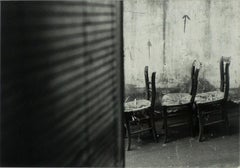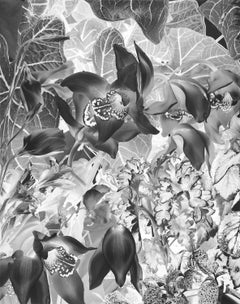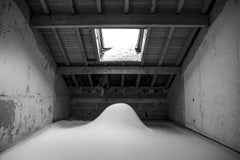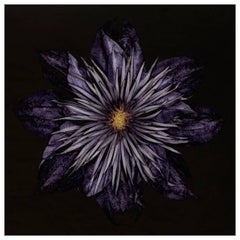Late 20th Century Still-life Photography
to
17
178
96
49
53
26
Overall Width
to
Overall Height
to
7
567
4,741
1
1
10
10
11
24
21
40
152
185
236
29
26
22
15
7
1
1
180
132
88
95
74
60
41
37
25
24
24
23
22
22
22
22
20
19
18
17
14
14
13
161
131
119
100
98
44
28
27
21
18
55
34
268
132
Period: Late 20th Century
Cellar Marigold Dandelion
Located in Miami, FL
86.IV.47 - 06 markings on sticker verso, Edition not know.
Matted and framed under glass, not examined out of frame.
Done for the American Express Company
Category
American Impressionist Late 20th Century Still-life Photography
Materials
Polaroid
'Chairs - Paris' original photograph by Leslie Borns
By Leslie Borns
Located in Milwaukee, WI
This image of empty broken chairs in a deserted alley is reminiscent of the work of Eugene Atget, who was capturing the streets of Paris over a 30 year pe...
Category
Contemporary Late 20th Century Still-life Photography
Materials
Photographic Paper
'Chairs - Paris' original photograph by Leslie Borns
By Leslie Borns
Located in Milwaukee, WI
This image of empty broken chairs in a deserted alley is reminiscent of the work of Eugene Atget, who was capturing the streets of Paris over a 30 year pe...
Category
Contemporary Late 20th Century Still-life Photography
Materials
Photographic Paper
Dark Sun No. 7
Located in New York, NY
For the past 30 years Barbara Jaffe has used her 4x5 inch view camera and a variety of black & white and expired pos/neg Polaroid films to create photographs that are a tribute to th...
Category
Contemporary Late 20th Century Still-life Photography
Materials
Archival Pigment
Une étrange rencontre
Located in PARIS, FR
"Certains lieux laissés à l’abandon suscitent parfois un certain intérêt dans notre imaginaire. Notamment pour ce qu’ils peuvent charrier de mystères. Ils nous intriguent, excitent notre curiosité. Comme s’ils avaient encore quelque chose à nous dire d’eux. À nous dire de nous. Chargés d’un passé aujourd’hui devenu leur présent, de singulières atmosphères règnent en de tels endroits et nous enjoignent parfois à y pénétrer avec prudence, s’offrant ainsi à quelque visiteur opportun." Basile Ducournau
Tirage numérique sur papier Etching Hahnemühle 350g, format 40x60cm, édition sur /10.
Possibilité de venir récupérer le tirage directement à la galerie.
Le prix...
Category
Late 20th Century Still-life Photography
Materials
Digital Pigment
Clematis - #2 of 5
Located in Aramits, Nouvelle-Aquitaine
Printed on archival fine art paper and signed, dated and numbered by the artist.
Edition #2 of 5.
About the artist: "I always felt that plants have a secret life. First, you don't ...
Category
Contemporary Late 20th Century Still-life Photography
Materials
Archival Pigment
Honesty - #2 of 5
Located in Aramits, Nouvelle-Aquitaine
Printed on archival fine art paper and signed, dated and numbered by the artist.
Edition #2 of 5.
About the artist: "I always felt that plants have a secret life. First, you don't ...
Category
Contemporary Late 20th Century Still-life Photography
Materials
Archival Pigment
Interior Tabletop with Porcelain in Spain
By Andy Warhol
Located in Beverly Hills, CA
This is a unique work.
Dated 'Jan 24 1983' (on the reverse). Stamped twice on the reverse by both The Estate of Andy Warhol and The Andy Warhol Foundation for the Visual Arts. The A...
Category
Pop Art Late 20th Century Still-life Photography
Materials
Silver Gelatin
Mack Truck
By Andy Warhol
Located in Beverly Hills, CA
This is a unique work.
Dated 'Nov 22 1982' (on the reverse). Stamped twice on the reverse by both The Estate of Andy Warhol and The Andy Warhol Foundation for the Visual Arts. The A...
Category
Pop Art Late 20th Century Still-life Photography
Materials
Silver Gelatin
$20,000
Windows
By Andy Warhol
Located in Beverly Hills, CA
This is a unique photographic work taken by Andy Warhol while visiting Catherine Guinness' English Estate in Gloucestershire in 1986.
Work comes with a Certificate of Provenance iss...
Category
Pop Art Late 20th Century Still-life Photography
Materials
Silver Gelatin
$18,000
Smoke, Fine Art Photography
Located in Vienna, AT
Smoke photographed by Jesse Frohman. All prints are limited edition. Available in multiple sizes. High-end framing on request. All prints are done and signed by the artist. The colle...
Category
Contemporary Late 20th Century Still-life Photography
Materials
Archival Pigment
Price Upon Request
Elle, Lego Balenciaga, Fine Art Photography
Located in Vienna, AT
Legs and Lego photographed by Jesse Frohman. All prints are limited edition. Available in multiple sizes. High-end framing on request. All prints are done and signed by the artist. T...
Category
Contemporary Late 20th Century Still-life Photography
Materials
Archival Pigment
Price Upon Request
Yellow Flower, St. Barts
By Ralph Gibson
Located in New York, NY
This is a photograph of a yellow flower in a Vase taken by Ralph Gibson in 1991.
This photograph, produced as a chromogenic print in an edition of 50 is being offered by CLAMP, in N...
Category
Contemporary Late 20th Century Still-life Photography
Materials
C Print
Price Upon Request
Classical Bust with Orchids, New York, 1988
Located in New York, NY
Signed by the photographer
Edition 9/10
Category
Late 20th Century Still-life Photography
Materials
Platinum
Price Upon Request
"Martha Stewart Living Magazine, Baking Pans", New York, NY, 1999
By Jose Picayo
Located in Hudson, NY
This photograph is printed on Japanese Paper.
The price is for an unframed photograph.
The Robin Rice Gallery is pleased to announce, 25 Years of Polaroids, a new exhibit by Jose Picayo. The opening reception will be held Wednesday, November 7th, from 6:00pm to 8:00pm. The exhibit will run through January 6, 2019.
In this exhibition, Picayo seeks to revive the concept of unadulterated beauty captured as a single moment in time. An unapologetic user of film, Picayo prides himself on his avoidance of digital processing for personal work. When asked why it remains his preferred medium, Picayo answers, “Digital is so overpoweringly real; photography is more magical to me.” For Picayo, Polaroid film is a medium where he can capture something as is – a moment in time. Just to hold the photograph in his hands is enough.
25 Years of Polaroids showcases Picayo’s most iconic work. This exhibit includes personal photographs of Cuba from 1994, Polaroid image transfers showcasing his impressive use of visual texture and his eye for fashion. Also included are his Atget-esque tree portraits from a New Jersey public arboretum in 2012. Additionally, a selection of 8” x 10” Polaroids from Mugshots 2008, will be included, exploring how a person’s soul can be captured in what appear to be basic photographs. The main questions at the heart of Picayo’s photography stem from the mystery of human perception and the precious things that are lost to time.
The invitational image, Rotating Doll, 1997, features a multi-paneled display of polaroids which cover an entire length of a wall. These 20” x 24” Polaroids appear larger than life and were given much praise in Picayo’s recent exhibit Polaroids 2016 at The Erie Museum in Erie, PA. This series stems from a collection of children’s dolls Picayo has found over the years, each one with its own strange and authentic story to tell. By cultivating a deteriorated look reminiscent of antique fresco painting, Picayo examines time using the inanimate faces of broken dolls, reflecting on the objects we hold dear and how they fall apart as we try to hold onto them.
Picayo speaks of his own influences, crediting photographers Eugène Atget, Walker Evans, and Edward Curtis, Michael Disfarmer, and Torkil Gudnason with impact on both his fine and commercial art. He is well known for his work in fashion, but for Picayo his personal and commercial work are interrelated, each extensions of one another. Born in Cuba, Picayo immigrated to Puerto Rico during his childhood and settled in New York City by the early 80s. After receiving his BFA from Parsons School of Design, Picayo began his professional career as a commercial photographer, shooting for magazines such as Vanity Fair, Sassy, Taxi, and Connoisseur. Picayo’s work has since appeared in Harper’s Bazaar, L.A. Style, New York Times Magazine, Esquire, Rolling Stone, NY Magazine, HG, and Elle Décor. Picayo has held nine solo exhibits to date at the Robin Rice Gallery.
still life, baking pans...
Category
Contemporary Late 20th Century Still-life Photography
Materials
Photographic Paper
Diptychon # 33
Located in Kansas City, MO
Diptychon # 33
Color photograph
Signed, numbered, dated and titled by hand
Edition: 12 + III
COA provided
Thomas Florschuetz (German, born 1960) recently emigrated from East Germany...
Category
Contemporary Late 20th Century Still-life Photography
Materials
Archival Ink, C Print, Archival Pigment
Price Upon Request
Bust with Ties, Paris
Located in New York, NY
Signed by the photographer
Category
Modern Late 20th Century Still-life Photography
Materials
C Print
Price Upon Request
Elton John, Dodger Stadium
Located in San Francisco, CA
Edition 2 of 50
Digitally Printed Signature and Edition number on Front.
Stamped by Estate
Terry O'Neill - photographer / English singer and songwriter Elton John performs at Dodger Stadium...
Category
Late 20th Century Still-life Photography
Materials
Silver Gelatin
Price Upon Request
Roses with Antique Head
Located in New York, NY
Photographer’s stamp on the verso
Category
Late 20th Century Still-life Photography
Materials
Photographic Paper
Price Upon Request
Caladium and Hosta Leaves
Located in New York, NY
Signed by the photographer
Category
Late 20th Century Still-life Photography
Materials
Photographic Paper
Price Upon Request
Pear with Seeds
By Irving Penn
Located in New York, NY
Pear with Seeds, June 1993/November 1993-February 1994
Signed, titled, dated, numbered, and inscribed in pencil, verso
Platinum-palladium print on Rives paper mounted to aluminum ...
Category
Contemporary Late 20th Century Still-life Photography
Materials
Platinum
Price Upon Request
Banjo (MRI), New York Hospital, NY, 1995
By Steve Miller
Located in Hudson, NY
Each year, Robin Rice celebrates a Salon style exhibition to showcase her gallery artists and invite new ones.
With Robin’s extensive experience as a gallery curator, all Robin Rice...
Category
Modern Late 20th Century Still-life Photography
Materials
Archival Pigment
Price Upon Request
Platonic Friendship
By Arthur Tress
Located in New York, NY
Signed, titled, and inscribed “for Paul” in black ink, recto
Gelatin silver print
14 x 11 inches, sheet
7.5 x 7.5 inches, image
This artwork is offered by ClampArt, located in New Y...
Category
Late 20th Century Still-life Photography
Materials
Silver Gelatin
Price Upon Request
The Empty Chair
Located in New York, NY
Gelatin silver print
Signed, titled, and dated in pencil, verso
This artwork is offered by ClampArt, located in New York City.
Over the course of more than two decades, Bruce Crats...
Category
Other Art Style Late 20th Century Still-life Photography
Materials
Silver Gelatin
Price Upon Request
"Untitled #11", New York, NY, 1997 Martha Stewart Magazine
By Jose Picayo
Located in Hudson, NY
This photograph is printed on Japanese Paper.
The price is for an unframed photograph.
The Robin Rice Gallery is pleased to announce, 25 Years of Polaroids, a new exhibit by Jose ...
Category
Modern Late 20th Century Still-life Photography
Materials
Photographic Paper
Priest
Located in New York, NY
Cibachrome print
Signed in pen, verso
This artwork is offered by ClampArt, located in New York City.
Category
Contemporary Late 20th Century Still-life Photography
Materials
Color
Price Upon Request
Mourning Tulips
By John Dugdale
Located in New York, NY
Cyanotype (Edition of 12)
Signed, titled, dated, and numbered on label, verso
This artwork is offered by ClampArt, located in New York City.
John Dugdale has received world acclaim...
Category
Other Art Style Late 20th Century Still-life Photography
Materials
Color
Price Upon Request
Armstrong’s Lunar Suit, Air & Space Museum, Washington D.C, 1990, Fine Art Print
Located in Los Angeles, CA
Archival Pigment Print
Category
Contemporary Late 20th Century Still-life Photography
Materials
Archival Pigment
Without Title (New York)
Located in Kansas City, MO
Titel: Without Title (New York)
Medium: Photograph
Year: 1974/2014
Publisher: Griffelkunst Hamburg
size: 7.4 × 10.7 on 11.5 × 15.4 inches
After a photographer training at the photo ...
Category
Pop Art Late 20th Century Still-life Photography
Materials
Photographic Paper
Price Upon Request
Eggs
Located in New York, NY
This photograph is an Edition of 36. All editions are signed by the photographer. Larger sizes may be available upon request.
Category
Late 20th Century Still-life Photography
Materials
Archival Pigment
Price Upon Request
Biblioteca del Abbazia di Kremsmunster, Germany
Located in New York, NY
Biblioteca del Abbazia di Kremsmunster, Germany, 1994
Chromogenic print mounted to aluminum
39.5 x 47.5 inches
edition of 5
Inquire for price
The photographer is based in...
Category
Contemporary Late 20th Century Still-life Photography
Materials
C Print
Price Upon Request
Miss Appleton's Shoes
Located in Carmel-by-the-Sea, CA
Signed by the artist on the back. Printed in 1983.
Category
Late 20th Century Still-life Photography
Materials
Silver Gelatin
Price Upon Request
Beauty and Beast II model in desert with monkey and giraffe in the back
By Michel Comte
Located in Vienna, AT
Other sizes and high-end frame on request. For decades Michel Comte has been shooting protagonists from the world of art, film and entertainment. However, he does not only take photo...
Category
Contemporary Late 20th Century Still-life Photography
Materials
Archival Pigment
Grand Central Terminal - black and white people walking in the train station
Located in Vienna, AT
Other sizes and high end framing on request. With his latest works, Andreas H. Bitesnich, the master of minutely detailed studio compositions proves that he is just as capable of cap...
Category
Contemporary Late 20th Century Still-life Photography
Materials
Archival Pigment
Paris the city view in black and white with clouds in the back
Located in Vienna, AT
Other sizes and high end framing on request. With his latest works, Andreas H. Bitesnich, the master of minutely detailed studio compositions proves that he is just as capable of cap...
Category
Contemporary Late 20th Century Still-life Photography
Materials
Archival Pigment
English National Opera #1, London, England - women behind the scences play cards
Located in Vienna, AT
Other sizes and prices on request. Gerard Uferas' photographs have appeared in numerous publications, including "Liberation", "Time Magazine", "The New York Times", "Le Monde", and "...
Category
Contemporary Late 20th Century Still-life Photography
Materials
Silver Gelatin
Ski Adaptation for Finnesko
Located in London, GB
Stamped with Scott Polar Research Institute blind stamp and numbered 1/30 on reverse
Platinum print
Available in two sizes:
20 x 14 inches, edition of 30
31 1/2 x 23 inches, edition...
Category
Late 20th Century Still-life Photography
Materials
Platinum
Price Upon Request
Sledging Rations for 1 Man for 1 Day
Located in London, GB
Stamped with Scott Polar Research Institute blind stamp and numbered 2/30 on reverse
Platinum print
Available in two sizes:
20 x 14 inches, edition of 30
31 1/2 x 23 inches, edition...
Category
Late 20th Century Still-life Photography
Materials
Platinum
Price Upon Request
"World Cup", 1999
By Steve Miller
Located in Hudson, NY
In this specific use of X-ray, Miller creates a collage-like composition that renders 3-D objects into 2-D space. The soccer ball floats as light as an orb or bubble, suspended among...
Category
Contemporary Late 20th Century Still-life Photography
Materials
Archival Paper
Price Upon Request
"Tulips", 1995
By Steve Miller
Located in Hudson, NY
A lovely bundle of tulips takes on a skeletal quality in this X-ray photograph by Steve Miller. The delicate, transparent petals of the tulip flowers are contrasted by the wiry const...
Category
Contemporary Late 20th Century Still-life Photography
Materials
Archival Paper
Price Upon Request
"Clarinet", 1997
By Steve Miller
Located in Hudson, NY
While all photography arrests motion, it is only the X-ray that allows us to climb inside a particular moment and subject and parse the structure of its beauty from within. Miller’s ...
Category
Contemporary Late 20th Century Still-life Photography
Materials
Archival Paper
Price Upon Request
"Sunflower", 1995
By Steve Miller
Located in Hudson, NY
While all photography arrests motion, it is only the X-ray that allows us to climb inside a particular moment and subject and parse the structure of its beauty from within.
Miller’...
Category
Contemporary Late 20th Century Still-life Photography
Materials
Archival Paper
Price Upon Request
Recently Viewed
View AllMore Ways To Browse
Vintage Ballerina Mirror
Vintage Celtics Poster
Vintage Fetish Heels
Vintage Hawaii Souvenir
Vintage Velvet Painting Mexico
Virgen De Guadalupe
Virgen Del Carmen
Virginia Shackles
Visser T Hooft
Volney Richardson
W R Jennings
Walter Biggs
Warhol Volkswagen
Watson Highland Cattle
Wesley Webber
Wesley Weber
William Bakaimo
William Dorsey





